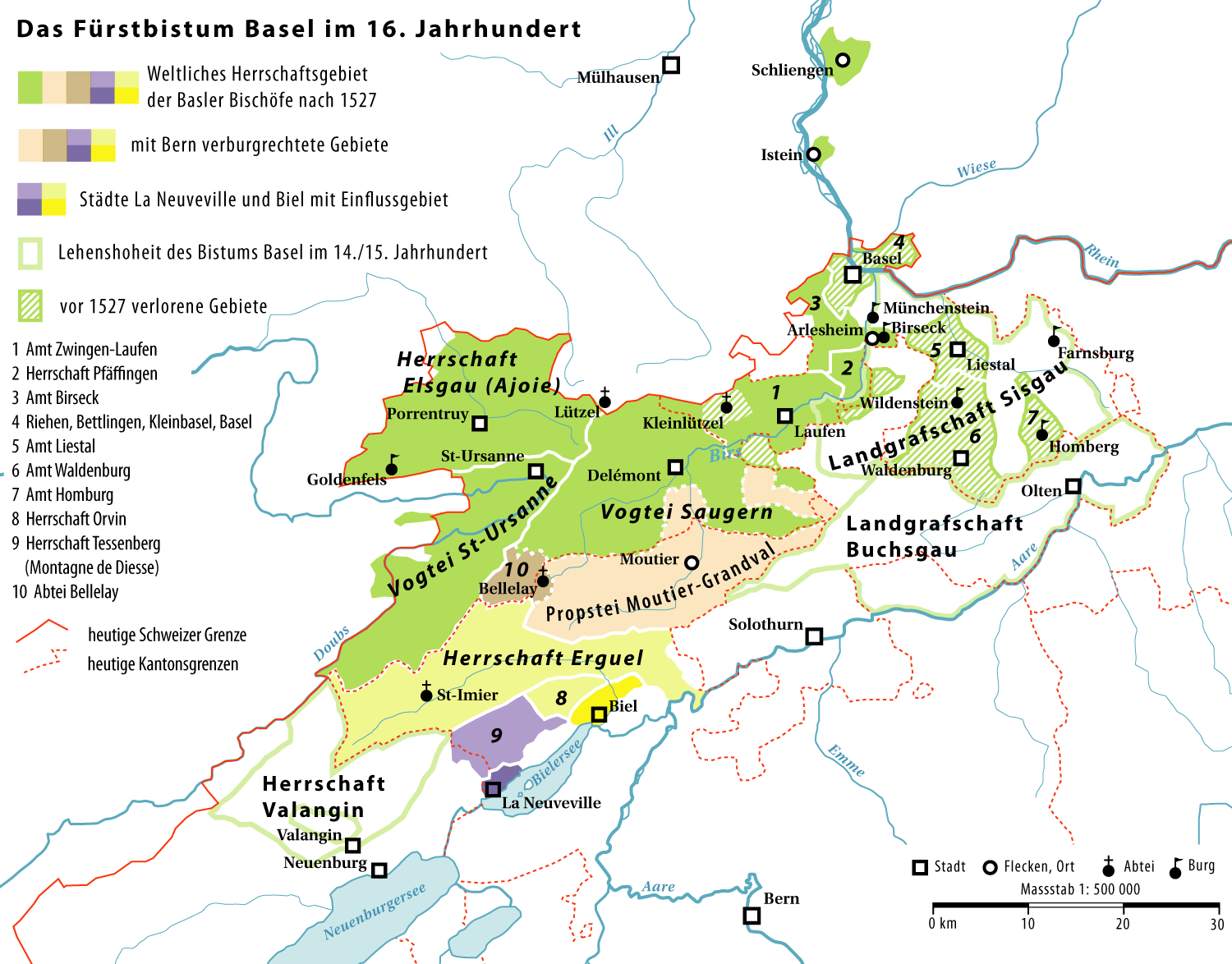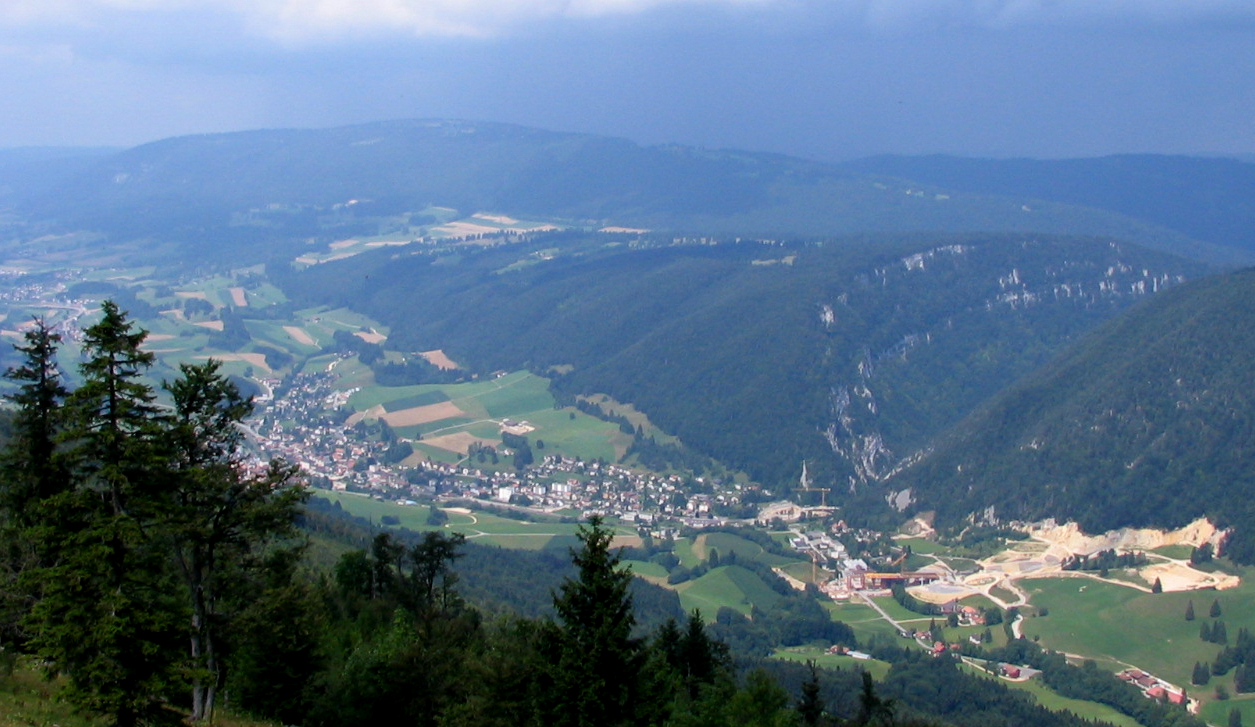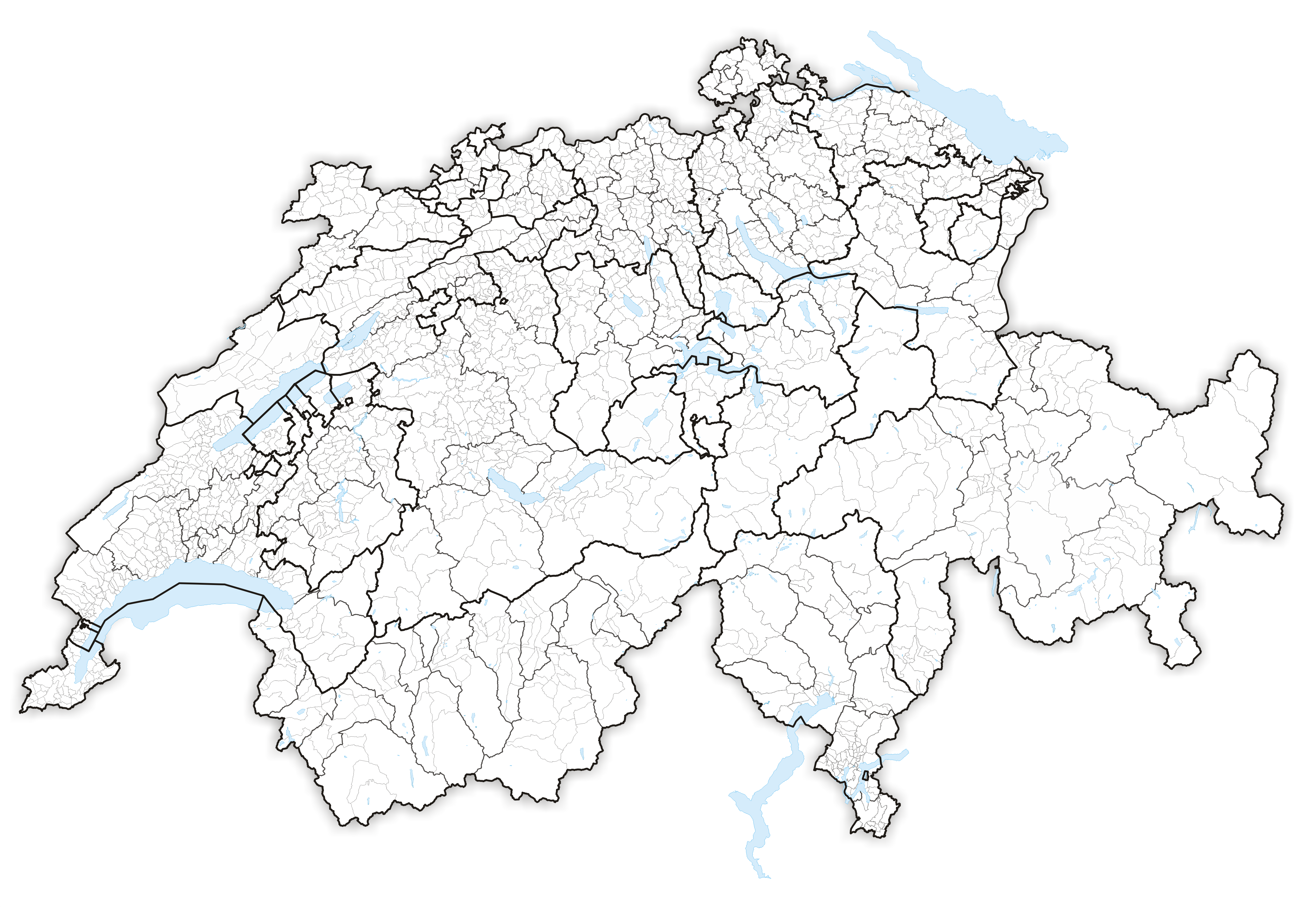|
Jura Bernois (administrative District)
Bernese Jura (french: Jura bernois, ) is the name for the French-speaking area of the Swiss canton of Bern, and from 2010 one of ten administrative divisions of the canton. Comprising the three French-speaking districts in the northern part of the canton, it contains 40 municipalities with an area of and a population () of . More than 90% of the population of the three districts speak French. The Bernese Jura of today comprises only three out of a total of seven districts which were known as the Bernese Jura during the period of 1815–1979. Of the remaining four, three seceded as the canton of Jura in 1979, while the fourth, the Laufen district, joined the canton of Basel-Landschaft in 1994. Additionally, Moutier, a municipality, voted to secede from Bern in a referendum in 2021 and join Jura, with the changeover expected to be implemented by 2026. History Most of the territory of the Bernese Jura was passed from the County of Burgundy to the Bishopric of Basel in AD ... [...More Info...] [...Related Items...] OR: [Wikipedia] [Google] [Baidu] |
Court, Switzerland
Court is a municipality in the Jura bernois administrative district in the canton of Bern in Switzerland. It is located in the French-speaking Bernese Jura (''Jura Bernois''). History Court is first mentioned in 1148 as ''Cort''. Between the 12th and 15th centuries the village of Mévilier or Minvilier existed between Court and Champoz. During the 15th Mévilier village was abandoned for an unknown reason. For most of its history, Court was part of the district of Orval which was owned by the provost of Moutier-Grandval Abbey. After the 1797 French victory and the Treaty of Campo Formio, Court became part of the French Département of Mont-Terrible. Three years later, in 1800 it became part of the Département of Haut-Rhin. After Napoleon's defeat and the Congress of Vienna, Court was assigned to the Canton of Bern in 1815. Originally, Court was part of the parish of Mévilier. By the 16th century it was part of the parish of Sorvilier. In 1531, Court adopted the new ... [...More Info...] [...Related Items...] OR: [Wikipedia] [Google] [Baidu] |
Napoleonic Period
The Napoleonic era is a period in the history of France and Europe. It is generally classified as including the fourth and final stage of the French Revolution, the first being the National Assembly, the second being the Legislative Assembly, and the third being the Directory. The Napoleonic era begins roughly with Napoleon Bonaparte's ''coup d'état'', overthrowing the Directory (9 November 1799), establishing the French Consulate, and ends during the Hundred Days and his defeat at the Battle of Waterloo (18 June 1815). The Congress of Vienna soon set out to restore Europe to pre-French Revolution days. Napoleon brought political stability to a land torn by revolution and war. He made peace with the Roman Catholic Church and reversed the most radical religious policies of the Convention. In 1804 Napoleon promulgated the Civil Code, a revised body of civil law, which also helped stabilize French society. The Civil Code affirmed the political and legal equality of all ... [...More Info...] [...Related Items...] OR: [Wikipedia] [Google] [Baidu] |
Gorges Du Pichou, Jura-Bern, Switzerland
{{disambiguation, geo, surname ...
Gorges, the plural of the French word for "throat", usually refers to a canyon. Gorges may also refer to: Places * Gorges, Loire-Atlantique, France * Gorges, Manche, France * Gorges, Somme, France * Cognin-les-Gorges, Isère, France * Three Gorges, a region in China * Fort Gorges, a fort in Maine People * Gorges family, Anglo-Norman gentry family * Ferdinando Gorges, founder of the Province of Maine * Josh Gorges, an NHL ice hockey player * Thomas Gorges (1536 – 30 March 1610), courtier to Queen Elizabeth I * Thomas Gorges (Maine governor), deputy governor of colonial 17th century Maine See also * Julia Görges (born 1988), German tennis player * Gorge (other) A gorge or canyon is a deep cleft resulting from weathering and the erosive activity of rivers. Gorge may also refer to: * Gorge (mythology), a figure from Greek mythology * Gorge FC, an American amateur soccer team * Gorge Trio, an American exper ... [...More Info...] [...Related Items...] OR: [Wikipedia] [Google] [Baidu] |
Moutier (district)
Moutier District was one of the three French-speaking districts of the Bernese Jura in the canton of Bern with the seat being Moutier Moutier () is a municipality in Switzerland. Currently, the town belongs to the Jura bernois administrative district of the canton of Bern. On 28 March 2021, the population voted to secede from the canton of Bern and join the Canton of Jura; the ..., the other two being Courtelary and La Neuveville. It had a population of about 23,098 in 2004. The three districts were merged on 1 January 2010 to form the new district of Jura Bernois with the capital at Courtelary. accessed 4 April 2011 References {{Coord, 47.2667, N, 7.36667, E, s ...[...More Info...] [...Related Items...] OR: [Wikipedia] [Google] [Baidu] |
La Neuveville (district)
La Neuveville District was one of three French-speaking districts of the Bernese Jura in the canton of Bern with the seat being La Neuveville, the other two being Courtelary and Moutier Moutier () is a municipality in Switzerland. Currently, the town belongs to the Jura bernois administrative district of the canton of Bern. On 28 March 2021, the population voted to secede from the canton of Bern and join the Canton of Jura; the .... It had a population of about 6,083 in 2004. The three districts were merged on 1 January 2010 to form the new district of Jura Bernois with the capital at Courtelary. accessed 4 April 2011 References {{Coord, 47.05, N, 7.08333, E, so ...[...More Info...] [...Related Items...] OR: [Wikipedia] [Google] [Baidu] |
Courtelary (district)
Courtelary District was located in Switzerland and was one of the three French-speaking districts of the Bernese Jura, along with La Neuveville and Moutier Moutier () is a municipality in Switzerland. Currently, the town belongs to the Jura bernois administrative district of the canton of Bern. On 28 March 2021, the population voted to secede from the canton of Bern and join the Canton of Jura; the .... The district was located in the canton of Bern with the seat being Courtelary. It had a population of about 22,224 in 2004. The three districts were merged on 1 January 2010 to form the new district of Jura Bernois with the capital at Courtelary. accessed 4 April 2011 R ...
|
Districts Of Switzerland
Districts of Switzerland are a political subdivision for cantons. In the federally constituted Switzerland, each canton is completely free to decide its own internal organisation. Therefore, there exists a variety of structures and terminology for the subnational entities between canton and municipality, loosely termed districts. Most cantons are divided into ''Bezirke'' (German for districts, singular ''Bezirk''). They are also termed ''Ämter'' (Lucerne, singular ''Amt''), ''Amtsbezirke'' (Bern, ''Amtsbezirk''), ''district'' (in French) or ''distretto'' (Ticino and part of Graubünden). The ''Bezirke'' generally provide only administration and court organization. However, for historical reasons districts in cantons Graubünden and Schwyz are their own legal entities with jurisdiction over tax and often have their own Landsgemeinde. Seven of the 26 cantons – Uri, Obwalden, Nidwalden, Glarus, Zug, Basel-City and Geneva – have always existed without the district level ... [...More Info...] [...Related Items...] OR: [Wikipedia] [Google] [Baidu] |
Biel (district)
Biel/Bienne District was a district (Amtsbezirk) in the canton of Bern in Switzerland with its seat Biel/Bienne , french: Biennois(e) , neighboring_municipalities= Brügg, Ipsach, Leubringen/Magglingen (''Evilard/Macolin''), Nidau, Orpund, Orvin, Pieterlen, Port, Safnern, Tüscherz-Alfermée, Vauffelin , twintowns = Iserlohn (Germany) .... It was bi-lingual (41% French and 59% German) and included two municipalities in an area of 25 km²: It is now part of the administrative district of Biel/Bienne. External links *Official Website of the city of Biel/Bienne [...More Info...] [...Related Items...] OR: [Wikipedia] [Google] [Baidu] |
Grand Council Of Bern
The Grand Council (german: Grosser Rat, french: Grand conseil) is the parliament of the Swiss canton of Bern. It consists of 160 members (as of 2006) elected by proportional representation for a four-year term of office. The French-speaking part of the canton, the Bernese Jura (districts of Courtelary, La Neuveville and Moutier) has 12 seats guaranteed, and 3 seats are guaranteed for the French-speaking minority of the bilingual district of Biel/Bienne. Election The council is re-elected every four years. Like other legislatures in Switzerland, elections use party list proportional representation. There are nine constituencies, based on the districts of the Canton. Composition The last election was held in 2018. References * External links All links are in German and French, unless otherwise noted. Official website of the Grand Council of Bern* German-language Wikipedia article on the Grand Council of Bern * Websites for th2002an2006Grand Council elections {{Poli ... [...More Info...] [...Related Items...] OR: [Wikipedia] [Google] [Baidu] |
Executive Council Of Bern
The Executive Council (german: Regierungsrat, french: Conseil-éxecutif) is the executive of the Swiss canton of Bern. This seven-member collegial body is elected by the people for a period of four years. The cantonal constitution reserves one seat in the Executive Council for a French-speaking citizen from the Bernese Jura. The presidency, by convention, rotates annually and the position is largely that of a ''primus inter pares''. Current Composition As of 2010, the Executive Council was composed as follows: * President of the Council Philippe Perrenoud, SPS: Health and Social Services Department * Vice President of the Council Bernhard Pulver, GFL: Education Department * Executive Councillor Andreas Rickenbacher, SPS: Economic Department * Executive Councillor Hans-Jörg Käser, FDP: Police and Military Department * Executive Councillor Christoph Neuhaus, SVP: Department of Justice, Municipalities and Churches * Executive Councillor Beatrice Simon, BDP: Finance Dep ... [...More Info...] [...Related Items...] OR: [Wikipedia] [Google] [Baidu] |
Biel/Bienne (administrative District)
Biel/Bienne District is an administrative district in the Canton of Bern, Switzerland. It is located along both shores of the northeastern half of Lake Biel and is part of the Seeland administrative region, and its capital is Biel/Bienne. It contains 19 municipalities with an area of and a population () of 90,536, over half of which lives in the district's capital. While it is the smallest district in surface area, it has the third largest population in the canton. The present Biel/Bienne ''Verwaltungskreis'' ("administrative district") was created on 1 January 2010, consisting of the entirety of one former ''Amtsbezirke'' ("district"), Biel, about half of another, Nidau Nidau is a municipality in the Biel/Bienne administrative district in the canton of Bern in Switzerland. History Nidau is first mentioned in 1196 as ''Nidowe''. In 1352, it was recorded in Latin as ''Nydow''. The remains of a number of st ... and three municipalities of Büren. References {{ ... [...More Info...] [...Related Items...] OR: [Wikipedia] [Google] [Baidu] |
Biel/Bienne
, french: Biennois(e) , neighboring_municipalities= Brügg, Ipsach, Leubringen/Magglingen (''Evilard/Macolin''), Nidau, Orpund, Orvin, Pieterlen, Port, Safnern, Tüscherz-Alfermée, Vauffelin , twintowns = Iserlohn (Germany) Biel/Bienne (official bilingual wording; , ) is a town and a municipality in the Biel/Bienne administrative district in the canton of Bern in Switzerland. Biel/Bienne lies on the language boundary between the French-speaking and German-speaking parts of Switzerland, and is bilingual throughout. ''Biel'' is the German name for the town; ''Bienne'' its French counterpart. The town is often referred to in both languages simultaneously. Since 1 January 2005, the official name has been "Biel/Bienne". Until then, the town was officially named Biel. The town lies at the foot of the first mountain range of the Jura Mountains area, guarding the only practical connection to Jura, on the northeastern shores of Lake Biel (, ), sharing the eastern t ... [...More Info...] [...Related Items...] OR: [Wikipedia] [Google] [Baidu] |



